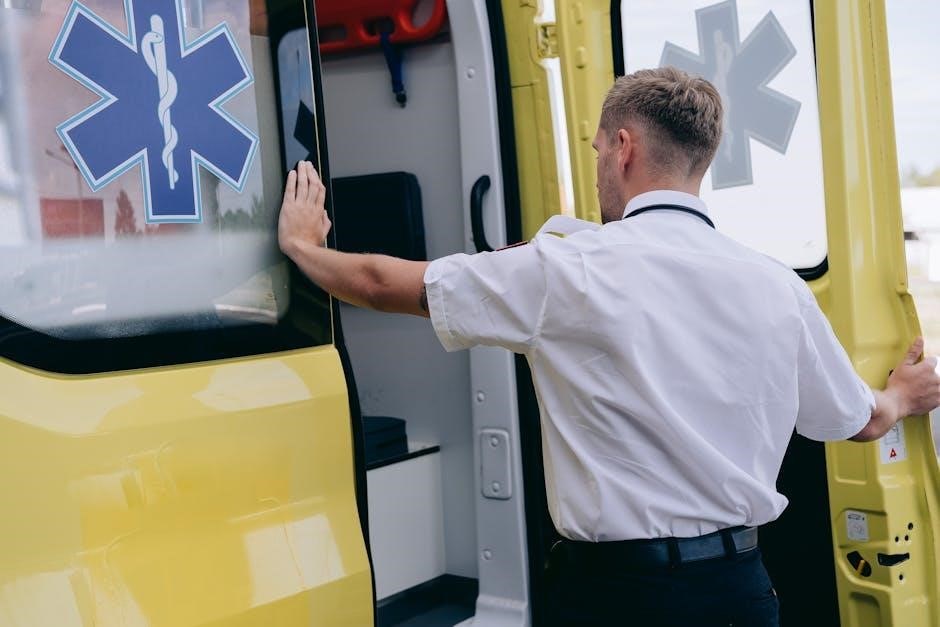first aid 2024 pdf
2024 First Aid Guidelines: An Overview
The American Heart Association (AHA) and American Red Cross (ARC) co-authored and released the 2024 First Aid Guidelines‚ offering critical updates based on evidence-based practices. These guidelines equip responders to effectively handle emergencies‚ from mild to life-threatening situations.
Co-Authorship and Release
The 2024 First Aid Guidelines represent a collaborative effort between the American Heart Association (AHA) and the American Red Cross (ARC). This partnership‚ ongoing since 2005‚ ensures the guidelines reflect the most current and evidence-based practices in first aid. The guidelines were officially released on November 14‚ 2024‚ marking a significant update to first aid protocols. This release follows a structured review of evidence from the International Liaison Committee on Resuscitation (ILCOR)‚ ensuring alignment with global resuscitation standards. The updated guidelines aim to provide first responders with the knowledge and skills necessary to effectively manage a wide range of medical emergencies. These emergencies encompass critical‚ common medical‚ traumatic‚ environmental‚ and toxicological conditions‚ improving patient outcomes.

Key Updates in the 2024 Guidelines
The 2024 guidelines provide detailed guidance on opioid overdoses‚ tick bites‚ and fainting. They also cover open chest wounds‚ bleeding‚ spinal motion restriction‚ seizures‚ heatstroke‚ hypothermia‚ frostbite‚ chest pain‚ and stroke.
Expanded Scope of Conditions
The 2024 First Aid Guidelines represent a comprehensive update‚ broadening the scope of conditions addressed compared to previous versions. Moving beyond basic first aid‚ the guidelines now offer detailed instructions for managing a wider array of medical‚ traumatic‚ environmental‚ and toxicological emergencies. This expansion includes specific guidance for situations such as open chest wounds‚ external bleeding management‚ and proper techniques for spinal motion restriction when injuries are suspected.
Furthermore‚ the updated guidelines provide protocols for addressing seizures‚ heatstroke‚ hypothermia‚ and frostbite‚ ensuring responders are equipped to handle diverse temperature-related emergencies. The inclusion of chest pain and stroke management protocols further enhances the guidelines’ comprehensive nature‚ providing critical information for time-sensitive interventions.
Opioid Overdose Management
A significant addition to the 2024 First Aid Guidelines is the inclusion of detailed guidance on managing opioid overdoses. Recognizing the increasing prevalence of opioid-related emergencies‚ the guidelines provide clear and concise instructions for first responders. This includes recognizing the signs and symptoms of an opioid overdose‚ such as slowed or stopped breathing and unresponsiveness.
The guidelines emphasize the importance of administering naloxone‚ a life-saving medication that can reverse the effects of opioids. They provide step-by-step instructions on how to administer naloxone‚ whether through intramuscular injection or nasal spray. Crucially‚ the guidelines also stress the need to call for emergency medical services immediately‚ even after administering naloxone‚ as the effects of the medication may wear off.
Tick Bite Management
The 2024 First Aid Guidelines address the growing concern of tick-borne illnesses by providing updated recommendations for tick bite management. The guidelines emphasize the importance of prompt and proper tick removal to minimize the risk of disease transmission. They recommend using fine-tipped tweezers to grasp the tick as close to the skin’s surface as possible and pulling upward with steady‚ even pressure.
The updated guidelines advise against using methods like burning or coating the tick with substances‚ as these can increase the risk of infection. After removing the tick‚ the area should be cleaned thoroughly with soap and water. The guidelines also recommend monitoring for signs of illness‚ such as rash or fever‚ and seeking medical attention if symptoms develop.
Organizations Involved
The 2024 First Aid Guidelines are a collaborative effort between the American Heart Association (AHA) and the American Red Cross (ARC). These organizations are leading providers of first aid training.
American Heart Association (AHA)
The American Heart Association is a founding member of the International Liaison Committee on Resuscitation (ILCOR)‚ reflecting its commitment to resuscitation science. AHA’s guidelines are used worldwide to train millions in CPR‚ emergency cardiovascular care‚ and first aid. They co-developed the 2024 First Aid Guidelines with the American Red Cross‚ incorporating ILCOR evidence reviews. The AHA provides detailed guidance on various scenarios‚ including those involving chest pain and stroke. They promote high-quality CPR and offer training resources. The AHA plays a vital role in disseminating the latest resuscitation science and practices.
American Red Cross (ARC)
The American Red Cross collaborated with the American Heart Association to co-develop the 2024 First Aid Guidelines‚ representing a comprehensive update since 2010. The ARC‚ alongside the AHA‚ incorporated structured evidence reviews from the International Liaison Committee on Resuscitation (ILCOR). These guidelines address diverse emergencies‚ covering medical‚ traumatic‚ environmental‚ and toxicological conditions. The American Red Cross has been added as a resource for HOSA CPR/First Aid guidelines. The ARC’s involvement ensures that first aid education aligns with current best practices. The joint guidelines provide official clinical practice recommendations‚ enhancing the effectiveness of first aid interventions.

Impact on Training and Courses
While immediate changes to Heartsaver courses aren’t planned‚ the training network should be aware of the science within the 2024 First Aid Guidelines. This ensures that future training reflects the most up-to-date information.
Heartsaver Courses
Currently‚ there will be no immediate changes made to Heartsaver courses or the associated training materials. However‚ it is crucial for the entire Training Network to be well-informed and aware of the updated scientific evidence presented in the 2024 Guidelines for First Aid. This awareness will ensure that the knowledge base of instructors and participants remains current and aligned with the latest recommendations in first aid practices.
The American Heart Association and American Red Cross jointly developed these guidelines‚ representing the first comprehensive update to first aid treatment recommendations since 2010. While the existing Heartsaver course content remains valid‚ understanding the new guidelines will enhance the quality and effectiveness of training.

Workplace First Aid Requirements
Business owners are adapting to changes in occupational health and safety regulations‚ requiring updates to workplace first aid requirements. New guidelines and resources are available to understand these regulatory changes for compliance.
Changes to Regulations
Several changes to workplace first aid regulations are taking effect. To assist in preparing for these new requirements‚ information about the updated workplace first aid curriculum and additional resources are being shared. These resources aim to help understand the first aid regulatory changes and ensure compliance.
Preliminary guidelines offer detailed information on the website. The new guidelines move beyond basic first aid to provide specific guidance on scenarios such as opioid overdoses and tick bites. The full guidelines are accessible on the First Aid Guidelines webpage. The goal is to improve workplace safety through updated protocols.

International Liaison Committee on Resuscitation (ILCOR)
The 2024 first aid guidelines demonstrate alignment with the International Liaison Committee on Resuscitation (ILCOR). The American Heart Association (AHA) is a founding member‚ and the International Federation of Red Cross and Red Crescent Societies is a collaborating member. ILCOR conducts structured evidence reviews‚ informing the updated recommendations.
These reviews cover various medical‚ traumatic‚ environmental‚ and toxicological conditions. The resulting guidelines offer clinical practice recommendations for first aid. The collaboration with ILCOR ensures that the guidelines are based on the most up-to-date resuscitation science. This partnership enhances the quality and effectiveness of first aid practices globally‚ promoting better outcomes in emergency situations.
HOSA CPR/First Aid Guidelines
The HOSA CPR/First Aid ILC Guidelines (October 2024) expect competitors to be aware of all content within the guidelines. The American Red Cross has been added as a resource for 2023-2024.
American Red Cross as a Resource
The 2024 HOSA CPR/First Aid guidelines now recognize the American Red Cross as a valuable resource. This addition means that for any discrepancies in CPR or First Aid steps between the American Heart Association and the American Red Cross‚ either set of guidelines can be utilized. During competitions‚ teams are expected to clearly communicate which organization’s guidelines they are following. This inclusion of the Red Cross reflects a broader approach to first aid education. This ensures that competitors are familiar with multiple accepted methodologies. This flexibility aims to prepare HOSA members for real-world scenarios where familiarity with diverse techniques can be life-saving. This update enhances the practical application of first aid knowledge within HOSA competitions.





